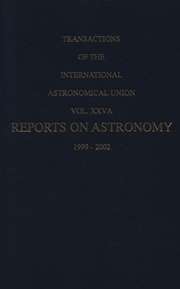No CrossRef data available.
Article contents
Commision 19: Earth Rotation (Rotation de la Terre)
Published online by Cambridge University Press: 25 April 2016
Extract
The period has been marked by the start of the new International Earth Rotation Service (IERS), which benefits from a tight cooperation between astronomers, geodesists, and specialists in satellite geodesy, as well as meteorologists. The scope of the IERS covers not only the Earth’s rotation per se, but also the conventional terrestrial reference frame, of direct interest to the International Association of Geodesy, and a high accuracy (0.001”) celestial reference frame based on extragalactic compact sources observed in Very Long Baseline Interferometry. The IERS conventional celestial reference frame is consistent with the FK5 within the uncertainties of the latter (0.04”). The IERS Standards (1989) which contain the current best estimates of astronomical models and constants are used in many fields of astronomy and geodesy.
- Type
- Research Article
- Information
- Copyright
- Copyright © Kluwer 1991


